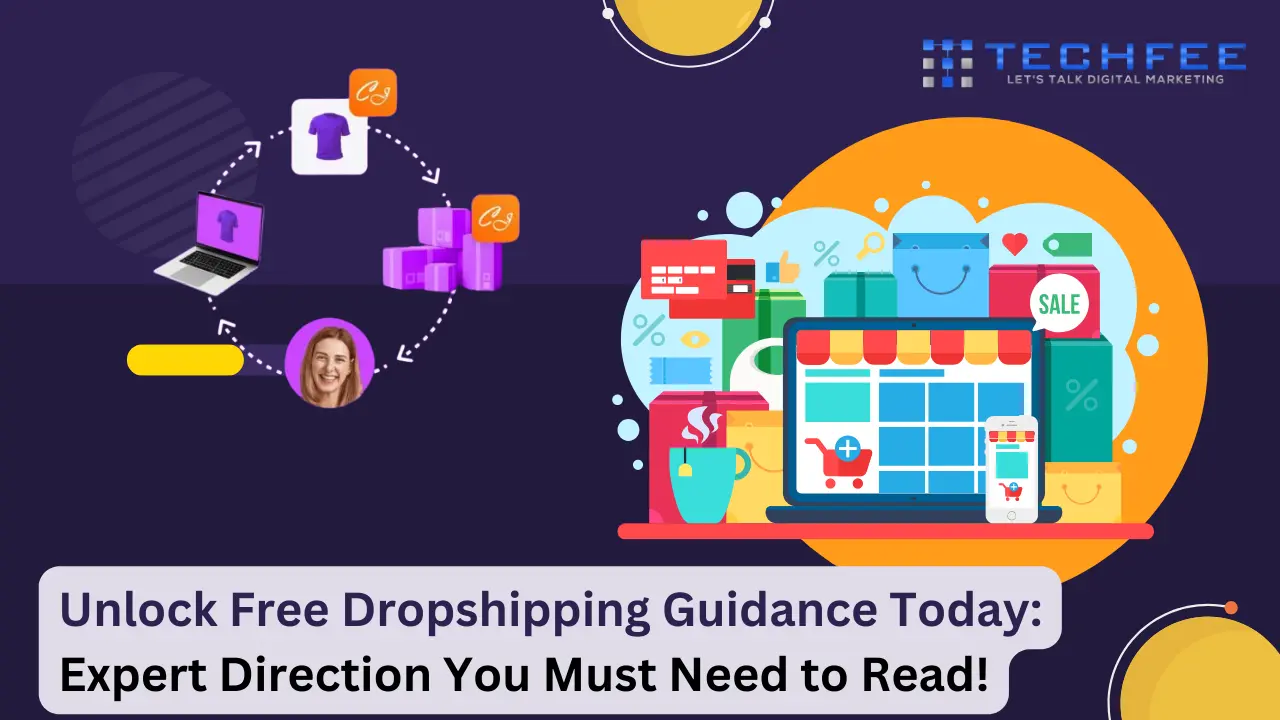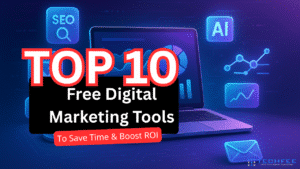In this complete guide, “How to Start Dropshipping for Free,” we will discuss how to start your own dropshipping business in 2024 with no money down.
Some people might think it’s impossible to start a business without any money to put down, but dropshipping makes it possible.
Imagine opening an online store without having to worry about stock, storage, or the costs of getting started.
Drop shipping is a new way to do business that is changing everything.
According to dropship.io, the success rate for dropshipping is thought to be between 10 and 20%. In 2023, more than 70% of all shopping website visits around the world were made on smartphones. 22% to 33% of online stores sell items on Amazon as dropshipping to make extra money. Dropshipping shops with at least one social media account make 32% more money.
This step-by-step guide will help you find your way around this lucrative chance, no matter where you are in the world—the US, India, Australia, South Africa, Pakistan, or Nigeria.
If you want to learn how to choose the right niche, find trustworthy suppliers, set up your online store, and market your goods well, all without spending a dime, read on.
Let’s get started and learn the expert tips and tricks to help you become a successful drop shipper!
What is Dropshipping?
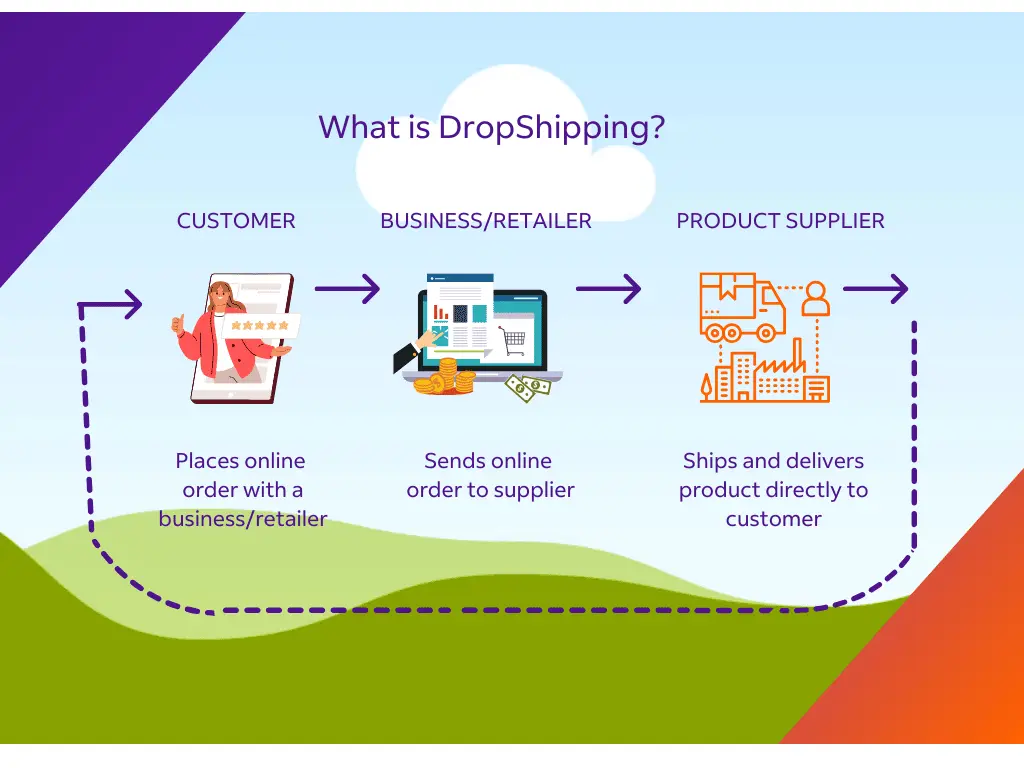
Dropshipping is a way for business owners to run an online store without having to keep any stock on hand.
Instead, when a store sells something, it buys it from a third-party seller, who then sends it straight to the customer.
In other words, the seller never has to touch the item themselves.
Drop shipping: How Does It Work?

Drop shipping starts when a customer places an order at your online store.
When you receive an order, you send the information about the purchase to your drop-shipping supplier, generally automatically.
The supplier then prepares the goods and ships them straight to the customer under your store’s name.
As the store owner, you make money when you sell the item for more than what you pay the seller.
Advantages of Drop Shipping
Dropshipping has a lot of great perks.
First, you need much less money to get started because you don’t have to buy goods immediately.
This lowers the risk to your money and lets you run a business that can quickly test new ideas and adjust to changing market conditions.
It also saves you time by allowing you to focus on marketing and customer service instead of worrying about storage, packing, and shipping.
You can get more products with dropshipping because you don’t have to store them all yourself. You can get them from different sellers.
Common Challenges in Dropshipping
Even though dropshipping has some benefits, it also has some problems.
Because you can’t always stop stock shortages or delays when you depend on suppliers, it can be hard to keep track of how much inventory you have.
Quality control can also be tricky because you don’t see the product until it gets to the customer. This means that the quality of the product might not be uniform.
The market can also be very competitive because many other business owners may be selling similar goods.
This is why making your store stand out and building a strong brand is important. It can also be more challenging to deal with returns and customer service problems if you aren’t in charge of the inventory yourself.
Dropshipping is a good and low-risk way to start an online business, but to avoid the problems it raises, you need to be very good at managing your supply relationships, marketing, and customer service.
Preparation Phase
When you first start a dropshipping business, the preparation part is very important because it sets you up for success.
In this step, you do a lot of research on the market and get to know your target audience to make sure your goods meet their needs.
Researching the Market
Identifying Profitable Niches
Finding profitable niches is the first thing that needs to be done in the planning phase.
You want to reach a certain group of people, which is called a niche.
To find a niche that will make you money, look for goods that people always want but that don’t have too many competitors.
You can use Google Trends, keyword research tools, and online markets to find out how popular and competitive a niche is.
Find an area that has just the right amount of demand and isn’t too crowded with other businesses. This will help you stand out.
Analyzing Competitors
After finding possible niches, the next step is to look at what your rivals are doing.
To do this, you need to look at other dropshipping shops in the same niche as yours to see what works and what doesn’t.
Look at what products they sell, how they set prices, how their website looks, how they market themselves, and what customers say about them.
You can learn about your rivals’ traffic sources and keywords they rank for with tools like SEMrush, Ahrefs, and SimilarWeb.
This research will help you find holes in the market that you can fill and strategies that you can use or make better.
Understanding Your Target Audience
Creating Buyer Personas
To make your products and marketing work better, you need to know who your target customer is.
First, make buyer personas, which are thorough profiles of the people you want to buy from you.
A person’s age, gender, level of income, and location are all examples of demographic information.
You should also include psychographic information, such as their hobbies, values, and shopping habits.
Making these characters helps you picture your ideal customers and make sure that your marketing messages are relevant to them.
Identifying Customer Pain Points
Along with making user personas, it’s important to know what your customers’ pain points are.
Pain points are specific issues or problems that the people you want to sell to have and that your goods can help them with.
Talk to possible customers through forums, surveys, and social media to find out what their pain points are.
Find problems and comments that people in your niche often have.
If you know about these problems, you can market your goods as solutions, which will make them more appealing and effective.
Setting up Your Dropshipping Business for Free
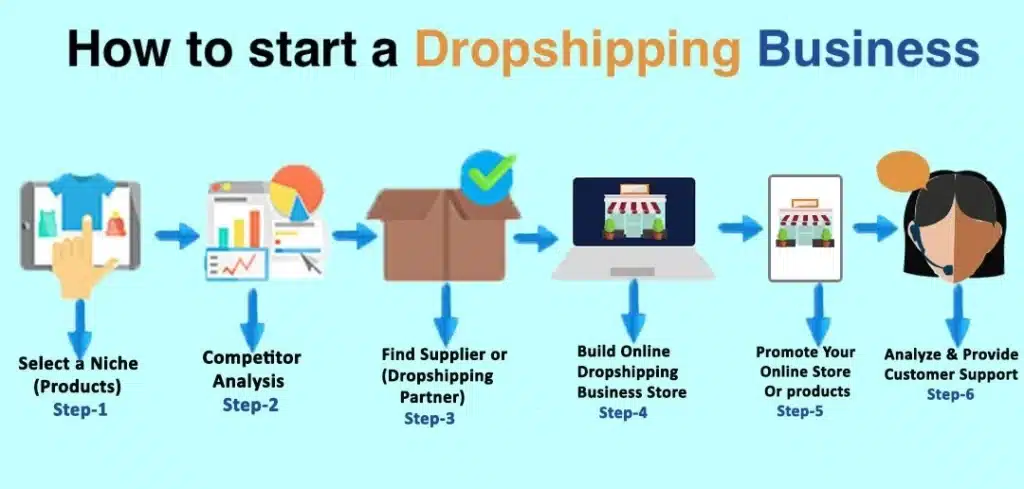
Setting up your dropshipping business without spending any money requires strategic decisions and resourcefulness.
This process involves choosing the right business model, selecting a suitable platform, and understanding the legal considerations involved.
Choosing a Business Model
Single Product Store: One-product stores only sell one type of thing.
With this model, you can work on promotion and your sales pitch for that product.
It works best if you find a special or popular product that can stand independently.
General Store: A general store offers a variety of products across different categories.
This model provides flexibility and the ability to test multiple niches.
However, it can be challenging to create a cohesive brand and marketing strategy.
Niche Store: A niche store targets a specific segment of the market with related products.
This model strikes a balance between the single product and general store models, allowing you to build a strong brand and loyal customer base within a focused niche.
Selecting a Platform
Using Free Ecommerce Platforms: To start your dropshipping business for free, you can use ecommerce platforms that offer free plans.
Platforms like WooCommerce (with WordPress) or Big Cartel provide basic features at no cost.
These platforms are user-friendly and have a range of plugins to support dropshipping operations.
Setting Up a Store on Social Media: Another cost-effective way to start is by setting up a store on social media platforms like Facebook, Instagram, or TikTok.
These platforms offer built-in shop features that allow you to list products and reach potential customers without upfront costs.
Social media stores are excellent for leveraging organic reach and building a community around your brand.
Legal Considerations
Registering Your Business: Even if you’re starting for free, it’s important to register your business to operate legally.
The process and cost of registration vary by location, but it often involves choosing a business name, registering with local authorities, and obtaining any necessary licenses.
Starting with a sole proprietorship or LLC can offer legal protections and credibility.
Understanding Tax Obligations: Familiarize yourself with the tax obligations in your region.
This includes sales tax, income tax, and any specific e-commerce taxes.
Using free resources from government websites or online business communities can help you understand these requirements.
Ensuring compliance with tax regulations will save you from potential legal issues and penalties in the future.
How to Start Dropshipping for Free Step by Step
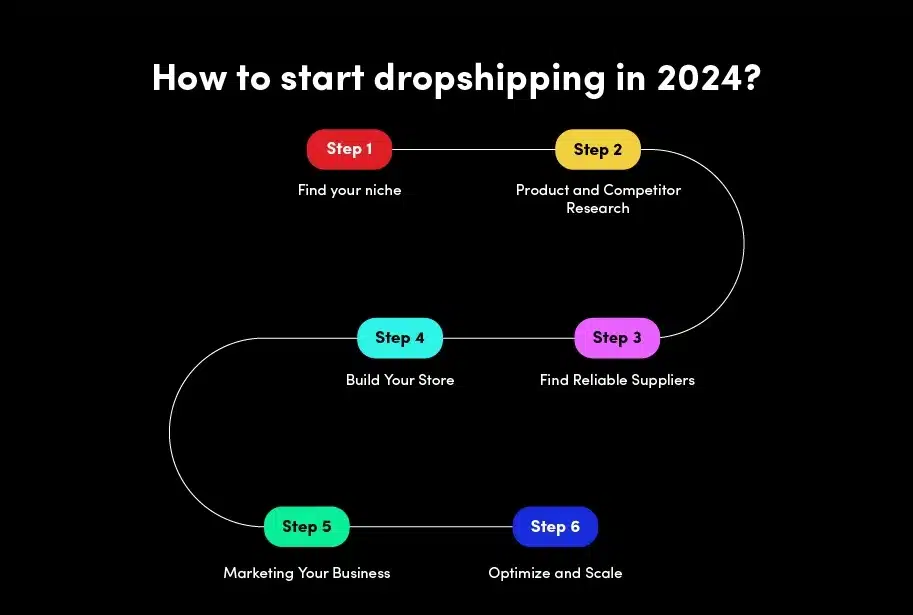
Starting a dropshipping business without any initial investment is entirely possible if you follow these detailed steps.
In this detailed guide, I will take you through the step-by-step process, ensuring you cover all the necessary aspects to set up and run your business successfully.
Step 1: Decide Your Niche & Products
The first step in starting your dropshipping business is to decide on a niche and the products you want to sell.
A niche is a specific segment of the market that you will target.
To find a profitable niche, consider your interests, market demand, and competition.
Use tools like Google Trends, keyword research tools, and ecommerce platforms to identify products that have steady demand but aren’t oversaturated.
This focused approach allows you to build a targeted marketing strategy and stand out in the market.
Step 2: Find Reliable Suppliers
After selecting your niche and products, the next step is to find reliable suppliers.
Reliable suppliers are crucial as they affect product quality and delivery times.
You can start by using free supplier directories like Alibaba, AliExpress, or Oberlo.
Contact multiple suppliers to compare their product offerings, prices, and shipping policies.
Building a good relationship with your suppliers can help ensure smooth operations and potentially better deals in the future.
Step 3: Set up Your Free Online Store
Setting up your online store without any costs involves using free ecommerce platforms.
Platforms like WooCommerce with WordPress, Big Cartel, or Ecwid offer free plans that allow you to set up a basic store.
Customize your store with a professional-looking design using free themes and templates.
Ensure your store includes essential pages like About Us, Contact, Shipping Information, and Return Policy to build trust with potential customers.
Step 4: Choose a Free Dropshipping Tool
To streamline your dropshipping operations, choose a free dropshipping tool.
Tools like Oberlo (with a free plan), Dropified, or Spocket can help automate product imports, order processing, and inventory management.
These tools integrate with your online store, making it easier to manage your dropshipping business efficiently.
Take advantage of free trials and basic plans to start without spending any money.
Step 5: Start Marketing Your Products
Marketing is essential to attract customers to your store.
Utilize free SEO marketing strategies to promote your products. Leverage social media platforms like Facebook, Instagram, and TikTok to reach your audience organically.
Create engaging content, run contests, and collaborate with influencers to increase your reach.
Additionally, start a blog or use video marketing to drive traffic to your store through content marketing.
Email marketing is another cost-effective way to keep in touch with potential customers and promote your products.
Step 6: Fulfill Orders Automatically
Once your marketing efforts start bringing in orders, set up automatic order fulfillment to streamline the process.
Many dropshipping tools offer automation features that automatically forward orders to your suppliers and update tracking information.
This ensures timely shipping and keeps your customers informed about their order status.
Automation saves time and reduces the risk of manual errors, allowing you to focus on growing your business.
By following these detailed steps, you can start your dropshipping business for free and set the stage for long-term success.
With careful planning, strategic use of free resources, and effective marketing, you can build a profitable dropshipping store without any initial investment.
Finding Suppliers
For your dropshipping business to succeed, you must find trustworthy suppliers.
Here are some good ways to get through this process without spending any money.
Identifying Reliable Suppliers
When looking for suppliers, trustworthiness, product quality, and shipping times should be at the top of your list.
Look for suppliers that other dropshippers have given good reviews and scores of.
Talk to possible suppliers directly to find out how responsive and professional they are.
Before agreeing to work together, ask for samples of the product to see how good it is for yourself.
Reliable suppliers make sure that your customers get their orders quickly and in good shape, which is good for the image of your store.
Utilizing Free Supplier Directories
To find possible sellers, use free supplier directories like Alibaba, AliExpress, and Oberlo.
You can find goods and sellers from all over the world in these listings.
You can narrow down your search by product type, region, and supplier rating.
To make smart choices, look at supplier profiles, customer comments, and past transactions.
You can look at many choices and find suppliers that meet your business’s needs without spending a lot of money by using free supplier directories.
Dropshipping Platforms with Free Plans
Look into dropshipping platforms that offer free plans to help you connect with sellers and run your business more efficiently.
Platforms like Oberlo, Spocket, and Dropified offer basic features for free, such as access to seller networks, tools for finding products, and systems for managing orders.
Use the platform’s free trials and simple plans to check out its features and see if they meet your business needs.
The management of suppliers is made easier by these tools, which also help automate process for fulfilling orders.
Building Relationships with Suppliers
If you want to be successful at dropshipping in the long run, you need to build strong relationships with your suppliers.
Talk to suppliers on a daily basis to stay open and honest, and take care of any problems right away.
Talk about prices, big discounts, and shipping terms to get the best deals and make the most money.
Make it clear what you expect in terms of product quality, packing, and shipping times.
When you build trust and dependability with your suppliers, you may get better service, faster order handling, and even deals that give your business special rights.
You can find trustworthy suppliers and make good partnerships without having to pay anything up front by using free supplier listings and dropshipping platforms with free plans.
Focus on building relationships based on trust, communication, and common goals to keep your dropshipping business running smoothly and keep customers happy.
Does Your Location Matter?
When it comes to dropshipping for free, your location can influence various aspects of your business setup and operations.
Here’s how you can navigate starting dropshipping in different regions without initial costs:
How to Start Dropshipping for Free in the United States
In the US, you can use ecommerce tools like Shopify’s free trial or WooCommerce with WordPress to start a dropshipping business for free.
Use free marketing strategies like SEO and social media to reach a lot of people without having to pay for ads.
Make sure you follow the local tax rules, and when choosing goods and suppliers, think about what American customers want.
How to Start Dropshipping for Free in India
In India, take advantage of platforms like Shopify, which offer initial free trials, or set up a store on social media platforms like Instagram or Facebook for free.
Focus on products that cater to local preferences and market demands.
Navigate legal considerations by registering your business and understanding GST implications for ecommerce transactions.
How to Start Dropshipping for Free in Australia
Dropshipping is possible in Australia with sites like Big Cartel and WooCommerce, which both offer free plans to get you started.
Make sure that the products you sell meet the needs of people in Australia, and look into free shipping choices to get people in Australia to buy from you.
You should learn about the GST rules and import rules for things that will be sold in Australia.
How to Start Dropshipping for Free in South Africa
Setting up a drop-shipping store in South Africa is easy with free plans for platforms like Shopify or WooCommerce.
Pay attention to goods that will sell well in South Africa and take into account local trends and consumer tastes.
Take care of the legal side by registering your business and learning about your VAT responsibilities for online sales in the country.
How to Start Dropshipping for Free in the United Kingdom
In the United Kingdom, platforms like Wix or Big Cartel offer free plans to launch your dropshipping business.
Target products that resonate with UK consumers and utilize free marketing strategies such as content marketing and email campaigns.
Stay compliant with VAT regulations and explore shipping options that cater to customers across the UK.
How to Start Dropshipping for Free in Europe
In Europe, you can start your selling business for free on sites like PrestaShop and OpenCart.
Change the products you sell to make them more appealing to different European languages and markets.
Learn about the EU VAT rules and customer protection laws that apply to online purchases made in the European Union. This will help you deal with complicated legal issues.
If you know about the possibilities and problems unique to each area, you can start and grow your dropshipping business for free.
Change how you do things to take advantage of how the local market works and the free tools and sites that are available in each area.
Marketing Your Dropshipping Store
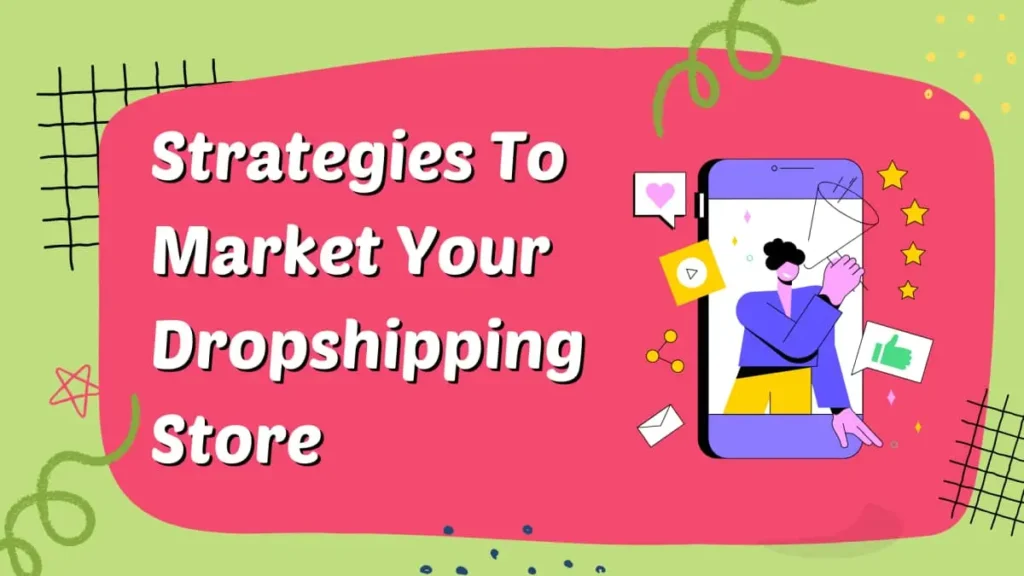
Effectively marketing your dropshipping store is crucial to attract customers and drive sales without spending money on traditional advertising.
Here’s how you can leverage various free marketing strategies:
Leveraging Social Media
Organic Marketing Strategies:
- Use social media platforms like Instagram, Facebook, and TikTok to build a presence for your dropshipping store organically.
- Create engaging posts, share valuable content related to your niche, and interact with your audience.
- Encourage user-generated content and leverage hashtags to expand your reach without paid promotions.
Using Influencer Partnerships: Collaborate with influencers who align with your brand and have a following that matches your target audience.
Reach out to influencers in your niche and propose partnerships such as product reviews, giveaways, or sponsored posts.
Influencer partnerships can help increase brand awareness and drive traffic to your store through trusted recommendations.
Content Marketing
Starting a Blog:
- Start a blog on your dropshipping store’s website to provide valuable information, tips, and insights related to your products or niche.
- Write informative articles, how-to guides, and product reviews that address common questions and challenges faced by your target audience.
- Optimize your blog posts for SEO to attract organic traffic from search engines.
Utilizing Video Marketing: Create engaging videos showcasing your products, demonstrating their uses, or sharing customer testimonials.
Platforms like YouTube, Instagram Reels, and TikTok are effective for video marketing. Use storytelling techniques and include calls-to-action (CTAs) to encourage viewers to visit your store or make a purchase.
Email Marketing
Building an Email List for Free:
- Build an email list of potential customers by offering incentives such as discounts, free guides, or exclusive content.
- Place opt-in forms on your website, blog, and social media profiles to capture email addresses.
- Use tools like Mailchimp, Sendinblue, or ConvertKit, which offer free plans for managing email campaigns and automating workflows.
Crafting Effective Email Campaigns: Create personalized and compelling email campaigns to nurture relationships with your subscribers and promote your products.
Segment your email list based on demographics, purchase history, or interests to deliver targeted messages.
Include engaging subject lines, clear CTAs, and visually appealing content that drives conversions.
Monitor email performance metrics like open rates and click-through rates to optimize your campaigns over time.
By implementing all these free marketing strategies effectively, you can increase brand visibility, engage with your target audience, and drive traffic to your dropshipping store.
Continuously monitor and adjust your marketing efforts based on analytics to maximize results and grow your business without upfront costs.
Optimizing Your Store for Conversions
Optimizing your dropshipping store for conversions is essential to turning visitors into customers without additional costs.
Here’s how you can effectively enhance your store’s performance:
Implementing SEO Best Practices
Keyword Research:
- Start by conducting keyword research to identify relevant search terms that potential customers use when looking for products in your niche.
- Use tools like Google Keyword Planner, Ubersuggest, or SEMrush to discover high-volume keywords with moderate competition.
- Incorporate these keywords naturally into your product descriptions, blog posts, and meta tags to improve visibility in search engine results.
On-Page SEO Techniques:
- Optimize your store’s pages for on-page SEO by optimizing title tags, meta descriptions, and headers with targeted keywords.
- Ensure that your website loads quickly, as page speed is a crucial ranking factor.
- Create unique and compelling content that addresses customer needs and includes relevant keywords.
- Use alt text for images and optimize URLs to make them descriptive and keyword-rich.
Utilizing Analytics Tools
Free Tools for Tracking Performance:
- Utilize free analytics tools like Google Analytics to track key metrics such as website traffic, user engagement, and conversion rates.
- Set up goals and track ecommerce metrics to measure the effectiveness of your marketing campaigns and website performance.
- Use Google Search Console to monitor search performance and identify opportunities for improvement.
Analyzing Customer Behavior:
- Analyze customer behavior on your website to gain insights into how visitors interact with your store.
- Use heatmaps, session recordings, and scroll maps from tools like Hotjar or Crazy Egg to visualize user behavior and identify areas of improvement.
- Monitor bounce rates, average session duration, and exit pages to understand where visitors are dropping off and optimize those pages for better conversion rates.
By implementing SEO best practices and utilizing analytics tools effectively, you can optimize your dropshipping store for conversions without incurring additional expenses.
Monitor performance metrics, refine your SEO strategies, and make data-driven decisions to improve user experience and drive more sales on your dropshipping website.
Managing Orders and Customer Service

Managing orders and providing excellent customer service are critical aspects of running a successful dropshipping business without upfront costs.
Here’s how you can effectively handle these responsibilities:
Automating Order Fulfillment
Automated order fulfillment makes it easier to handle and ship orders without having to do it by hand.
Use dropshipping tools like Oberlo, Dropified, or Spocket to automate order handling.
When you connect these tools to your e-commerce platform, they will send orders to suppliers instantly, keep track of shipments, and let customers know about the tracking information.
Automation cuts down on mistakes, speeds up the order handling process, and makes everything more efficient, so you can focus on growing your business.
Handling Returns and Refunds
Dealing with returns and refunds is a necessary part of online shopping, and it should be done quickly and properly to keep customers happy.
Make sure that your website’s return and refund rules are clear and easy for customers to understand. Make these rules clear on the product pages and when people are checking out.
Give customers more than one way to return items or get their money back, like email or a special customer service site.
Refunds should be processed quickly once you receive the returned things, and you should keep customers informed throughout the process to build trust and loyalty.
Providing Exceptional Customer Support
Giving great customer service is important for keeping people and building good relationships with them.
Give your customers a lot of ways to get help, like email, live chat, and social media.
Answer customer questions or concerns right away and politely, and make sure you’ve answered them.
Train your support team or answer questions yourself to make sure that conversation and problem-solving are always the same.
When you can, personalize your interactions with customers to make them feel like they are important and respected.
You can make customers happier by giving great customer service, get them to buy from you again, and spread the word about your dropshipping store.
Scaling Your Dropshipping Business
Scaling your dropshipping business involves expanding operations strategically to increase revenue and market reach without initial investment.
Here’s how you can effectively scale your business:
Diversifying Your Product Range
You can appeal to a wider audience and meet the needs of customers with different tastes by offering a variety of products.
Look at market trends, customer feedback, and sales data to find goods that go well with what you already sell. Slowly add more products to your catalog by adding new groups or variations.
Think about yearly patterns and what customers want to make sure you have the best selection of products and the most sales.
By offering a variety of products, you can bring in new customers and get old ones to buy from you again.
Exploring Paid Advertising Options
While starting dropshipping for free focuses on organic and cost-effective marketing strategies, exploring paid advertising options can accelerate growth and reach targeted audiences more effectively.
Invest in pay-per-click (PPC) advertising on platforms like Google Ads or social media ads on Facebook, Instagram, or Pinterest.
Set clear objectives and budgets for your campaigns, targeting specific demographics, interests, and geographic locations.
Monitor campaign performance closely and optimize ad creatives, targeting parameters, and bidding strategies based on analytics to maximize return on investment (ROI).
Expanding to International Markets
Expanding to international markets opens up new opportunities for growth and revenue generation.
Research and identify target markets with high demand for your products and favorable economic conditions.
Utilize ecommerce platforms that support international shipping and multi-currency transactions, such as Shopify with integrated payment gateways.
Adapt your marketing strategies and product offerings to suit local preferences, languages, and cultural nuances.
Consider logistics and customs regulations to ensure seamless delivery and customer satisfaction across borders.
By expanding internationally, you can diversify your customer base, mitigate seasonal fluctuations, and capitalize on global ecommerce trends.
By diversifying your product range, exploring paid advertising options, and expanding to international markets strategically, you can scale your dropshipping business effectively and achieve sustainable growth.
Continuously analyze market dynamics, consumer behavior, and competitive landscapes to make informed decisions and optimize your business operations for long-term success.
Pros and Cons of Free Dropshipping Business
Starting a dropshipping business for free offers several advantages and comes with its own set of challenges.
Here’s a detailed look at the pros and cons:
Pros of Free Dropshipping
Low Initial Investment: One of the primary benefits of starting a free dropshipping business is that it requires minimal upfront investment. You can avoid costs associated with inventory storage, product sourcing, and fulfillment, making it accessible for beginners or those with limited capital.
Flexibility and Scalability: Free dropshipping allows you to test multiple products and niches without financial risk. You can easily add or remove products from your store and scale your business as it grows, adjusting operations based on customer demand and market trends.
Ease of Setup: Setting up a dropshipping store with free ecommerce platforms and tools is relatively straightforward. You can launch your store quickly, select products, and start selling without the complexities of traditional retail operations.
Wide Product Selection: With dropshipping, you can offer a wide range of products sourced from various suppliers without holding inventory. This flexibility enables you to cater to diverse customer preferences and expand your product catalog effortlessly.
Cons of Free Dropshipping
Lower Profit Margins: Since dropshipping involves paying suppliers for each sale, profit margins can be lower compared to traditional retail models. High competition in popular niches may also lead to pricing pressures, affecting profitability.
Dependency on Suppliers: Your business’s success relies heavily on the reliability and efficiency of your suppliers. Issues such as stockouts, shipping delays, or quality control problems can impact customer satisfaction and harm your reputation.
Limited Control Over Product Quality and Shipping: As a dropshipper, you have limited control over product quality, packaging, and shipping times. Poor-quality products or long shipping durations can result in negative customer experiences and increased return rates.
Marketing and Customer Acquisition Costs: While starting for free mitigates initial costs, attracting and retaining customers through effective marketing requires ongoing investment of time and resources. Paid advertising and marketing campaigns may be necessary to scale your business and compete effectively.
Understanding the pros and cons of free dropshipping can help you make informed decisions and mitigate challenges as you build and grow your ecommerce venture.
By leveraging the advantages and addressing the drawbacks, you can navigate the competitive landscape and maximize the potential of your dropshipping business.
Conclusion: How to Start Dropshipping for Free
Finally, starting your dropshipping path without any initial investment can open up a lot of doors for people who want to be entrepreneurs in 2024.
We’ve talked about the basics of dropshipping in this guide, from researching the market and setting up your store to marketing strategies and ways to grow your business, all without needing a lot of money.
You can get around problems and make the most of this flexible business plan by using free e-commerce platforms, social media, and strategic relationships with suppliers.
The future of dropshipping will continue to change as e-commerce technology and global market trends get better.
People’s online shopping habits and tastes are always changing, so the dropshipping industry has a lot of room for growth and new ideas.
Whether you’re going after local customers or going global, it’s important to keep up with new trends and use digital marketing tools.
When you’re ready to start dropshipping, remember that the key to success is to keep learning, change based on feedback, and keep working to make your operations run more smoothly.
To build a long-lasting and profitable dropshipping business, start by finding a niche and researching your market.
Then, put these ideas into action. You can make your business dreams come true and do well in the fast-paced world of ecommerce if you are determined and plan your actions carefully.
Start right now to set yourself up for business success in dropshipping.
If you found this post informative, please leave a comment below saying, “I found this post informative.”
Additionally, we encourage you to share this post with others to help educate more people.
Also, don’t forget to subscribe to our email newsletter to receive more informative content like this directly in your inbox.
FAQs: How to Start Dropshipping for Free
What is the best platform for starting a free dropshipping store?
Shopify offers a 14-day free trial, but WooCommerce is a free option if you already have a WordPress site.
How can I find reliable suppliers without spending money?
Use platforms like AliExpress, Oberlo, and SaleHoo directories, or network in dropshipping forums and social media groups.
What are the most effective free marketing strategies for dropshipping?
Utilize social media marketing, content marketing (blogs, YouTube), and SEO.
How do I handle customer complaints and returns?
Have a clear return policy, respond promptly and professionally, and work closely with your suppliers to resolve issues.
Can dropshipping be sustainable in the long term?
Yes, with the right niche, supplier relationships, and marketing strategies, it can be sustainable.
How to start dropshipping on Amazon?
Create an Amazon seller account, list products from suppliers, and manage orders through the Amazon platform.
Is dropshipping worth it?
It can be profitable with low upfront costs but requires significant effort and good market research.
Is dropshipping legal?
Yes, dropshipping is legal, but you must comply with business and tax regulations.
Can dropshipping make you rich?
It can be lucrative, but success depends on market selection, marketing, and efficient operations.
What dropshipping products are more successful?
Trending, niche, and unique products often perform better.
When did dropshipping start?
The concept has been around for decades, but it became popular in the e-commerce space in the early 2000s.
Who invented dropshipping?
There's no single inventor; it evolved over time as a business model.
Can I start dropshipping for free?
Yes, using free platforms like WooCommerce and free trials of other tools.
How can a beginner start dropshipping?
Choose a niche, find a reliable supplier, set up an online store, and start marketing your products.
Who pays first in dropshipping?
The customer pays you first, and then you pay the supplier.
What is the highest income for dropshipping?
Income varies widely; top earners can make six to seven figures annually.
Can you dropship private label products for free?
No, private labeling usually requires upfront investment.
Is AliExpress dropshipping free?
Yes, but consider product costs and shipping fees.
What is required to drop ship?
An online store, reliable suppliers, and marketing strategies.
How do I start dropshipping with a free e-commerce website?
Use free platforms like WooCommerce with WordPress, find suppliers, and start listing products.
